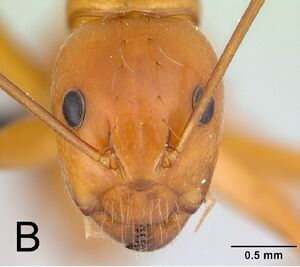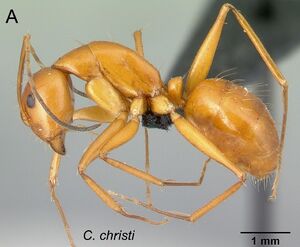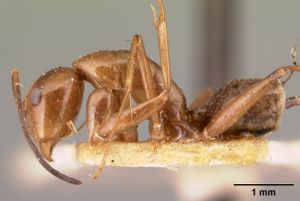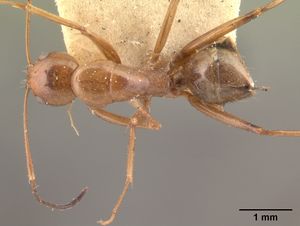Camponotus christi
| Camponotus christi | |
|---|---|

| |
| Scientific classification | |
| Kingdom: | Animalia |
| Phylum: | Arthropoda |
| Class: | Insecta |
| Order: | Hymenoptera |
| Family: | Formicidae |
| Subfamily: | Formicinae |
| Tribe: | Camponotini |
| Genus: | Camponotus |
| Subgenus: | Mayria |
| Species: | C. christi |
| Binomial name | |
| Camponotus christi Forel, 1886 | |
Camponotus christi is widely distributed across Madagascar. It occupies sclerophyll forests of the central high plateau, tropical dry forests in the west to coastal scrub and littoral rainforests, as well as montane rainforests in the east. While its workers have been found foraging on the forest floor and the lower portions of vegetation, their nest sites have been located in root mats in the ground layer, rotten logs, rotting tree stumps, rotten pockets above the ground, dead branches and bamboo above the ground, and in canopy moss and leaf litter.
Identification
A member of the subgenus Mayria (see diagnosis). Rakotonirina and Fisher (2018) - Median portion of clypeus without longitudinal carina; mandible with six teeth; anteromedian margin of clypeus not bordered by a lamella; in lateral view, mesosoma long and low, its dorsal outline not a dome-like structure; propodeal declivity inclined anteriorly; body color entirely yellow to light brown, legs with same color as body.
Workers of C. christi are similar to those of Camponotus mainty, Camponotus foersteri and Camponotus maculiventris in that their clypeus lacks a median longitudinal carina, and in lateral view, their mesosoma is long and low. However, C. christi workers are easily separable by their entirely yellow to light brown body color and legs. In the members of C. mainty, their body is entirely black to reddish-black. In the two latter species, at least the trochanters and the distal portion of the coxa are yellowish to white.
Keys including this Species
Distribution
Latitudinal Distribution Pattern
Latitudinal Range: -13.58487° to -24.7585°.
| North Temperate |
North Subtropical |
Tropical | South Subtropical |
South Temperate |
- Source: AntMaps
Distribution based on Regional Taxon Lists
Malagasy Region: Madagascar (type locality).
Distribution based on AntMaps
Distribution based on AntWeb specimens
Check data from AntWeb
Countries Occupied
| Number of countries occupied by this species based on AntWiki Regional Taxon Lists. In general, fewer countries occupied indicates a narrower range, while more countries indicates a more widespread species. |

|
Estimated Abundance
| Relative abundance based on number of AntMaps records per species (this species within the purple bar). Fewer records (to the left) indicates a less abundant/encountered species while more records (to the right) indicates more abundant/encountered species. |

|
Biology
Castes
Worker
Minor
                   
| |
| . | |
Queen
Images from AntWeb
   
| |
| Queen (alate/dealate). Specimen code casent0101522. Photographer Nick Olgeirson, uploaded by California Academy of Sciences. | Owned by MHNG, Geneva, Switzerland. |
Nomenclature
The following information is derived from Barry Bolton's Online Catalogue of the Ants of the World.
- christi. Camponotus christi Forel, 1886f: 184 (w.) MADAGASCAR.
- Type-material: lectotype minor worker (by designation of Rakotonirina & Fisher, 2018: 19), 1 paralectotype minor worker.
- Type-locality: lectotype Madagascar: “Centre and south of centre of Madagascar” (no further data) (J.M. Hildebrandt); paralectotype with same data but collected by (P. Camboué).
- [Notes (i): the original description only cites material collected by Hildebrandt, and the only depository cited is MNHU; (ii) the Camboué material originates in Forel, 1891b: 63, therefore the paralectotype designation is redundant.]
- Type-depositories: MHNG (lectotype); MNHN (redundant paralectotype).
- Combination in C. (Myrmocamelus): Forel, 1914a: 270;
- combination in C. (Myrmosaga): Emery, 1920b: 257;
- combination in C. (Mayria): Emery, 1925b: 122;
- combination in C. (Myrmonesites): Rasoamanana & Fisher, 2022: 147.
- Rakotonirina & Fisher, 2018: 21 (s.).
- Status as species: Forel, 1891b: 63 (redescription); Dalla Torre, 1893: 224; Emery, 1896d: 373 (in list); Wheeler, W.M. 1922a: 1045; Emery, 1925b: 122; Bolton, 1995b: 92; Rakotonirina & Fisher, 2018: 19 (redescription).
- Distribution: Madagascar.
Unless otherwise noted the text for the remainder of this section is reported from the publication that includes the original description.
Description
Worker
Rakotonirina and Fisher (2018) - Minor. In full-face view, head elongate (CWb/CL: 0.76±0.03; 0.69–0.83), lateral margins straight and more or less parallel to each other, rounding broadly to the slightly, medially excised posterior margin. Anterior clypeal margin straight, with broadly angulate junction to lateral margin; median longitudinal carina absent. Eyes not breaking lateral outlines of head; their posterior margin located approximately at posterior third portion of head (PoOc/CL: 0.34±0.01; 0.31–0.36). Mandible triangular, apical margin with six sharp teeth. Antennal scape long, more than its distal half extending beyond posterior cephalic border. In lateral view, pronotum and anterior half of mesonotum forming feeble convexity, posterior half of mesonotum and propodeal dorsum straight and long, joining declivity surface with noticeable angle. Propodeal dorsum roughly three times as long as height of declivity; propodeal spiracle circular. Petiolar node as high as or higher than long, its dorsal margin rounding to anterior face and joining posterior face at an angle.
Dorsum of head covered with numerous yellowish, elongate, erect hairs; pronotum and mesonotum each with a pair of erect hairs, propodeum with a pair of hairs found on junction to declivity; sparse, short pubescence present on dorsum of body. Body color entirely yellowish-orange to orange-brown and funicular segments becoming dark brown toward the apex.
Major. Differing from minor worker in the following characters: enlarged head, with markedly concave posterior margin; apical third of antennal scape surpassing posterior cephalic margin; robust mesosoma, metanotum distinctly visible, propodeal dorsum rounding to declivity and twice as long as height of declivity; petiolar node tapering dorsally. More pairs of erect hairs on junction of propodeal dorsum and declivity and on posterodorsal margin of petiolar node.
Type Material
- Lectotype (designated by Rakotonirina & Fisher, 2018: 18), minor worker, Centre de Madagascar [Ambatomanjaka, Miarinarivo, 1344 m], Madagascar, 18°46′01″S 46°52′09″E / 18.766947°S 46.869107°E, Hildebrandt, AntWeb CASENT0101544, Musee d'Histoire Naturelle Genève.
- Paralectotype (designated by Rakotonirina & Fisher, 2018: 18), minor worker, Centre de Madagascar [Ambatomanjaka, Miarinarivo, 1344 m], Madagascar, 18°46′01″S 46°52′09″E / 18.766947°S 46.869107°E, Camboué, CASENT0101435, Musee National d'Histoire Naturelle.
References
- Emery, C. 1920b. Le genre Camponotus Mayr. Nouvel essai de la subdivision en sous-genres. Rev. Zool. Afr. (Bruss.) 8: 229-260 (page 257, combination in C. (Myrmosaga))
- Emery, C. 1925d. Hymenoptera. Fam. Formicidae. Subfam. Formicinae. Genera Insectorum 183: 1-302 (page 122, combination in C. (Mayria))
- Forel, A. 1886h. Études myrmécologiques en 1886. Ann. Soc. Entomol. Belg. 30: 131-215 (page 184, worker described)
- Forel, A. 1914a. Le genre Camponotus Mayr et les genres voisins. Rev. Suisse Zool. 22: 257-276 (page 270, combination in C. (Myrmocamelus))
- Rakotonirina, J.C., Fisher, B.L. 2018. Taxonomic revision of the Malagasy Camponotus subgenus Mayria (Hymenoptera, Formicidae) using qualitative and quantitative morphology. Zootaxa 4438: 1–58 (DOI 10.11646/zootaxa.4438.1.1).
- Rasoamanana, N., Fisher, B.L. 2022. A taxonomic revision of the Malagasy endemic subgenus Mayria of the genus Camponotus (Hymenoptera, Formicidae) based on qualitative morphology and quantitative morphometric analyses. ZooKeys 1081: 137–231 (doi:10.3897/zookeys.1081.71872).
- Wheeler, W. M. 1922k. Ants of the American Museum Congo expedition. A contribution to the myrmecology of Africa. IX. A synonymic list of the ants of the Malagasy region. Bull. Am. Mus. Nat. Hist. 4 45: 1005-1055 (see also)
References based on Global Ant Biodiversity Informatics
- Emery C. 1886. Saggio di un catalogo sistematico dei generi Camponotus, Polyrhachis e affini. Memorie della Reale Accademia delle Scienze dell'Istituto di Bologna 5: 363-382
- Emery C. 1899. Formiche di Madagascar raccolte dal Sig. A. Mocquerys nei pressi della Baia di Antongil (1897-1898). Bullettino della Società Entomologica Italiana 31: 263-290.
- Fisher B. L. 1997. Biogeography and ecology of the ant fauna of Madagascar (Hymenoptera: Formicidae). Journal of Natural History 31: 269-302.
- Fisher B. L. 2003. Formicidae, ants. Pp. 811-819 in: Goodman, S. M.; Benstead, J. P. (eds.) 2003. The natural history of Madagascar. Chicago: University of Chicago Press, xxi + 1709 pp.
- Forel A. 1886. Études myrmécologiques en 1886. Annales de la Société Entomologique de Belgique. 30: 131-215.
- Rakotonirina J. C., and B. L. Fisher. 2018. Taxonomic revision of the Malagasy Camponotus subgenus Mayria Hymenoptera, Formicidae) using qualitative and quantitative morphology. Zootaxa 4438: 1-58.
- Wheeler W. M. 1922. Ants of the American Museum Congo expedition. A contribution to the myrmecology of Africa. IX. A synonymic list of the ants of the Malagasy region. Bulletin of the American Museum of Natural History 45: 1005-1055

